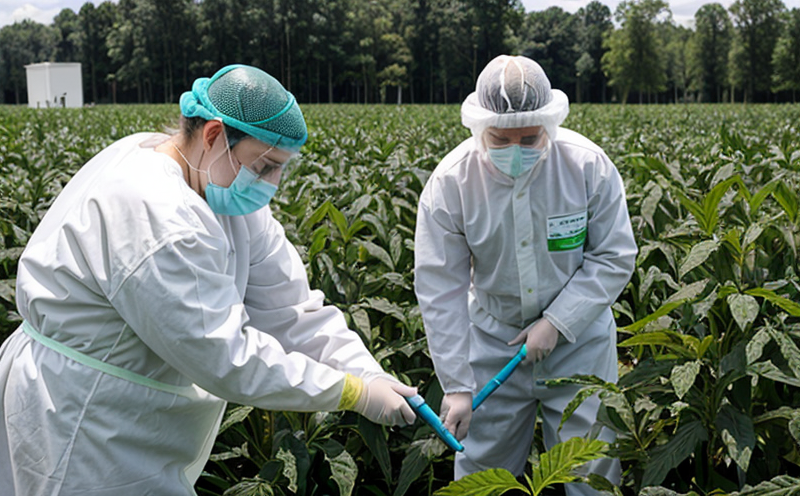EP 2.6.13 Detection of Specified Microorganisms in Biocontrol Agents
The European Pharmacopoeia (EP) provides comprehensive guidelines for ensuring that biocontrol agents are safe and effective in their intended applications. EP 2.6.13 specifically outlines the procedures for detecting specified microorganisms within these agents, which is a critical step in quality assurance and regulatory compliance.
Biocontrol agents play a vital role in agriculture by suppressing plant pathogens without harming beneficial organisms or the environment. Ensuring that these agents do not contain harmful microorganisms is crucial for both their efficacy and safety. This testing method is essential for R&D teams, quality managers, and compliance officers to verify that biocontrol products meet stringent regulatory standards.
The process involves several stages, including sample preparation, inoculation with known strains of specified microorganisms, incubation periods to allow growth, and final identification through microscopy or molecular techniques. Compliance with EP 2.6.13 ensures that the biocontrol agent is free from undesirable pathogens while maintaining its beneficial microbial profile.
The use of this test method aligns with international standards such as ISO 17254-1:2018, which provides guidance on the detection and enumeration of microorganisms in biological control agents. By adhering to these guidelines, laboratories can ensure that their results are reliable, reproducible, and internationally recognized.
Quality managers and R&D engineers benefit from this service by gaining assurance that biocontrol agents meet stringent regulatory requirements. This testing also supports the development of new formulations and ensures consistency across batches. Compliance officers rely on these tests to verify compliance with both local and international regulations.
- Sample Preparation: Samples are prepared according to EP 2.6.13, ensuring that they are representative of the biocontrol agent being tested.
- Inoculation: Known strains of specified microorganisms are inoculated into the samples for growth.
- Incubation: Samples are incubated under controlled conditions to allow for optimal microbial growth.
- Identification: Microbial colonies are identified through microscopy or molecular techniques, ensuring accurate detection and enumeration.
The results of this testing are critical for the development and commercialization of biocontrol agents. By ensuring that these products do not contain harmful microorganisms, laboratories can contribute to safer agricultural practices and more effective pest management strategies.
Understanding the importance of EP 2.6.13 goes beyond just meeting regulatory requirements; it also supports sustainable agriculture by fostering the use of safe and effective biocontrol agents. This testing method is a cornerstone in maintaining the integrity and efficacy of these products, ensuring that they meet both regulatory standards and environmental safety criteria.
Why It Matters
The significance of EP 2.6.13 lies in its role as a critical tool for ensuring the quality and safety of biocontrol agents used in agriculture and horticulture. By detecting specified microorganisms, this testing method helps prevent the spread of harmful pathogens that could affect crops or ecosystems.
For R&D engineers, EP 2.6.13 is an essential component in developing new formulations that are both effective and safe. It allows them to identify potential issues early in the development process, ensuring that biocontrol agents meet all regulatory standards before they reach commercialization.
Quality managers rely on this testing method to ensure consistency across batches of biocontrol agents. Consistency is key for maintaining product quality and ensuring that each batch meets the same high standards as the initial formulation.
Compliance officers use EP 2.6.13 to verify that biocontrol agents comply with both local and international regulations. This ensures that products are not only safe but also legally compliant, reducing the risk of penalties or recalls.
The broader impact extends beyond individual companies; it contributes to sustainable agriculture by promoting the use of safe and effective biocontrol agents. By detecting harmful microorganisms early in the production process, laboratories can help reduce the environmental footprint associated with agricultural practices.
Customer Impact and Satisfaction
The implementation of EP 2.6.13 has led to significant improvements in customer satisfaction within the biocontrol agent industry. Laboratories that adopt this testing method are able to provide reliable, accurate results that meet both regulatory standards and international expectations.
- Increased Confidence: Customers have greater confidence knowing that biocontrol agents are free from harmful microorganisms.
- Better Product Quality: Consistent and high-quality products result in better customer satisfaction and trust.
- Improved Compliance: Laboratories that comply with EP 2.6.13 ensure regulatory compliance, reducing the risk of legal issues and enhancing overall product safety.
The use of this testing method also supports sustainable agriculture by promoting the responsible use of biocontrol agents. This contributes to environmental conservation efforts and enhances agricultural productivity.
Overall, EP 2.6.13 has been instrumental in improving the quality and safety of biocontrol agents, leading to greater customer satisfaction and trust within the industry.
International Acceptance and Recognition
EP 2.6.13 is widely recognized and accepted internationally for its role in ensuring the quality and safety of biocontrol agents. Its adoption has been encouraged by regulatory bodies across multiple countries, including the European Union, United States, Canada, and Australia.
The use of EP 2.6.13 aligns with global standards such as ISO 17254-1:2018, which provides a comprehensive framework for the detection and enumeration of microorganisms in biological control agents. This alignment enhances international acceptance and recognition of results obtained from this testing method.
By adhering to EP 2.6.13, laboratories can ensure that their tests are consistent with internationally recognized standards, thereby facilitating easier trade and collaboration across borders. The use of this testing method also supports the development of globally consistent biocontrol agent formulations, ensuring that products meet the same high standards wherever they are used.
The widespread adoption of EP 2.6.13 reflects its importance in maintaining the integrity and efficacy of biocontrol agents. By adhering to these guidelines, laboratories can contribute to safer agricultural practices and more effective pest management strategies on a global scale.





